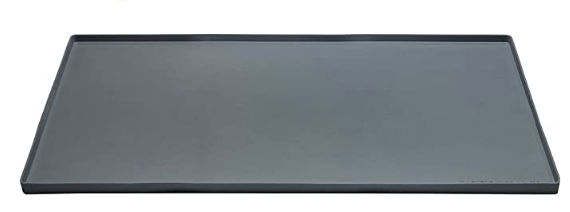Moisture Mitigation aka Mold!
We increasingly understand the harmful effects of mold on one's overall health. Monitoring and managing moisture and mold growth within the home is important*. While I am not an expert in mold remediation, controlling moisture away from surfaces that could foster growth is a good step toward managing mold. These are a few of the items I use within my home that I recommend (you can find them in my Amazon store as well):
Moisture Control Tools
Image from Amazon
Pipe leaks are a frequent source of water leaks. Placing a mat under the sink that is large enough to cover the base of your cabinets or vanity allows time to catch small and slow leaks without causing damage.
2. Dehumidifier
Image from Amazon
The EPA recommends household humidity preferably be below 50%. Depending on where you live, humidity may or may not be an issue, but a dehumidifier may be a good investment if your home tends to be over a 50% humidity level. You want the dehumidifier to lower the entire humidity of the home to a reasonable level, not just a single room. Check what a good humidity level is for your home and area.
Other humidifiers: I found several models that match the capacity of the one I liked (50 pints, for large rooms/basements) but differ in brand, smart features, or price point. For example, if your basement is used as a play or workshop space, you might opt for the 50-pint or even 80-pint size. If it’s just a damp corner or a mid-sized room, maybe 35 pints is enough.
Image from Amazon
Mold can start to grow in as little as 24 hours. Having a fan or some kind of air mover available to help dry out large sudden spills or leaks quickly is beneficial.
Image from Amazon
A moisture meter allows you to check moisture readings within the home on various surfaces. This little tool can catch leaks early and give you confidence in calling a water mitigation company if you suspect a moisture issue in the home. Common areas to check are door and window framings, under sinks, and behind toilets. This also allows you to check suspicious spots, such as any changes in appearance to ceiling patches or warping baseboards.
Image from Amazon
Some appliances have auto leak detection shut-offs, but even then I like to add a stainless steel or plastic pan under the washing machine and dishwasher. This will hold water from small leaks that would otherwise go unnoticed.
Image from Dorai Home
Bath mats are a consistently damp surface, ideal for bacterial and microbial growth. Instead, I prefer to use Dorai Home Bath Stones, which absorb water instantly, dry quickly, are non-slip, and are made of high-quality, sustainable materials.
It is a good practice to schedule a day once a month to check for leaks and moisture around the house. Look under appliances and sinks using a moisture meter. Make sure to look around tubs, sinks, washing machines, and toilets and repair any failed silicone or caulking. Inspect the bathroom, laundry, kitchen floor, baseboards, or walls for warping. Examine window seals for moisture or condensation. Monitor ceilings for changes in appearance, such as discoloration or texture inconsistency. Lastly, check the attic and crawl spaces a few times yearly for mold, water, or a musty smell. Consistent moisture checks will help cultivate and maintain a healthy home by keeping mold at bay.
*If you have a mold growth issue or significant water damage, I recommend calling a certified mold inspector in your area to guide you through the remediation process. The above tools can help mitigate moisture and mold growth before it becomes an issue but will not replace proper water and mold remediation.






